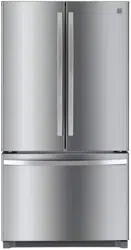Documents: Go to download!
- Owner's manual - (English)
- PARTS AND FEATURES
- REFRIGERATOR INSTALLATION
- USING YOUR REFRIGERATOR
- CONNECTING THE WATER LINE
- CARE AND CLEANING
- TROUBLESHOOTING GUIDE
Table of contents
User manual Refrigerator
PARTS AND FEATURES
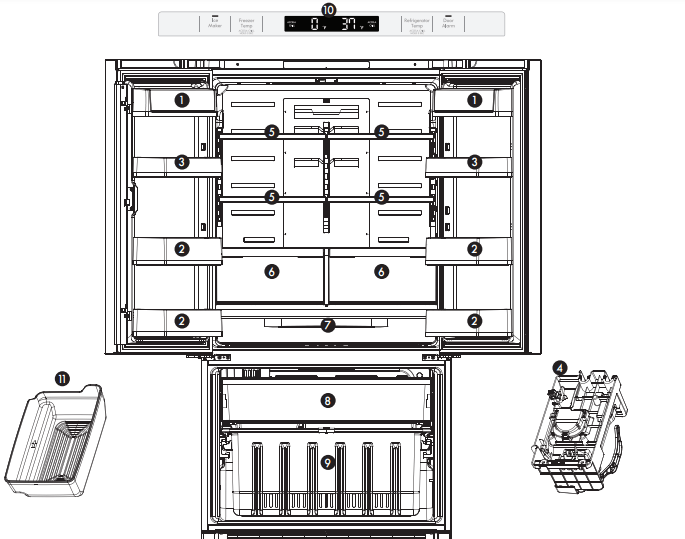
* This instruction manual refers to several models. Features may vary according to model.
1. Covered Dairy Bin or Covered Storage Bin for storing butter and cheese.
2. Gallon door storage bin for items of medium to large size.
3. Low profile door storage bin for items of medium to large size.
4. Ice maker for making ice.
5. Adjustable glass shelf for items of medium to large size.
6. Humidity controlled Crisper Bin for storage of fruits and vegetables
See other models: 73042 71215
7. Full width pantry drawer for storage of miscellaneous small items
8. Pull out freezer drawer
9. Lower freezer basket for general freezer storage
10. Control and display panel
11. Ice storage bin
REFRIGERATOR INSTALLATION
UNPACKING YOUR REFRIGERATOR
Remove tape and any temporary labels from your refrigerator before using. Do not remove any warning- type labels, the model and serial number label, or the Tech Sheet that is located under the front of the refrigerator.
To remove any remaining tape or glue, rub the area briskly with your thumb. Tape or glue residue can also be easily removed by rubbing a small amount of liquid dish soap over the adhesive with your fingers. Wipe with warm water and dry.
Do not use sharp instruments, rubbing alcohol, flammable fluids, or abrasive cleaners to remove tape or glue. These products can damage the surface of your refrigerator.
Refrigerator shelves are installed in the shipping position. Please reinstall shelves according to your individual storage needs.
PRIOR TO USE
- Clean your refrigerator thoroughly and wipe off all dust that accumulated during shipping.
- Install accessories such as ice cube bin, drawers, shelves, etc., in their proper places. They are packed together to prevent possible damage during shipment.
- Allow your refrigerator to run for at least two to three hours before putting food in it. Check the flow of cold air in the freezer compartment to ensure proper cooling. Your refrigerator is now ready for use.
INSTALLATION
The refrigerator should always be plugged into its own individual properly grounded electrical outlet rated for 115 Volts, 60 Hz, AC only, and fused at 15 or 20 amperes. This provides the best performance and also prevents overloading house wiring circuits which could cause a fire hazard from overheated wires. It is recommended that a separate circuit serving only this appliance be provided.
- To avoid noise and vibration, the unit must be leveled and installed on a solidly constructed floor. If required, adjust the leveling legs to compensate for unevenness of the floor. The front should be slightly higher than the rear to aid in door closing. Leveling legs can be turned easily by tipping the cabinet slightly. Turn the leveling legs to the left to raise the unit or to the right to lower it. (See Leveling and door AlIgnment.)
- NOTE: Installing on carpeting, soft tile surfaces, a platform or weakly supported structure is not recommended.
- Install this appliance in an area where the temperature is between 55°F (13°C) and 110°F (43°C). If the temperature around the appliance is too low or high, cooling ability may be adversely affected.
- Select a place where a water supply can be easily connected for the automatic icemaker.
- NOTE: The water pressure must be from 30 to 125 psi or 207-862 kPa or 2.1-8.8 kgf/cm². If the refrigerator is installed in an area with low water pressure below 30 psi, you can install a booster pump to compensate for the low pressure.
- Too small of a distance from adjacent items may result in lowered freezing capability and increased electricity consumption charges. Allow at least 2 inch (5 cm) between the back of the refrigerator and the wall.
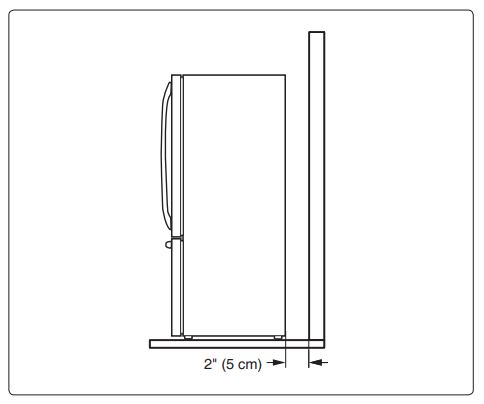
NOTE: Removing the doors is always recommended when it is necessary to move the refrigerator through a narrow opening. If it is necessary to remove the handles, follow the directions below.
HOW TO REMOVE REFRIGERATOR DOOR HANDLE
NOTE: Handle appearance may vary from the illustrations on this page.
Removing Refrigerator Handle
Loosen the set screws with the 2.5mm hex key provided and remove the handle.
HOW TO REPLACE REFRIGERATOR DOOR HANDLE
NOTE: Handle appearance may vary from the illustrations on this page.
Removing Refrigerator Handle
Place the handle on the door by fitting the handle footprints over the mounting fasteners and tightening the set screws with a hex key
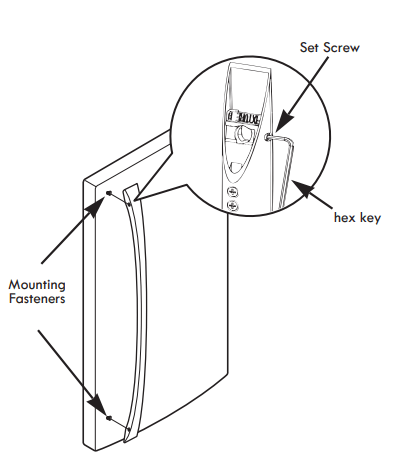
NOTE: Removing the doors is always recommended when it is necessary to move the refrigerator through a narrow opening. If it is necessary to remove the handles, follow the directions below.
HOW TO REMOVE FREEZER DOOR HANDLE
NOTE: Handle appearance may vary from the illustrations on this page.
Removing Freezer Drawer Handle
Loosen the set screws located on the lower side of the handle with the hex key provided and remove the handle.
HOW TO REPLACE FREEZER DOOR HANDLE
NOTE: Handle appearance may vary from the illustrations on this page.
Replacing Freezer Drawer Handle
Place the handle on the door by fitting the handle footprints over the mounting fasteners and tightening the set screws with a hex key
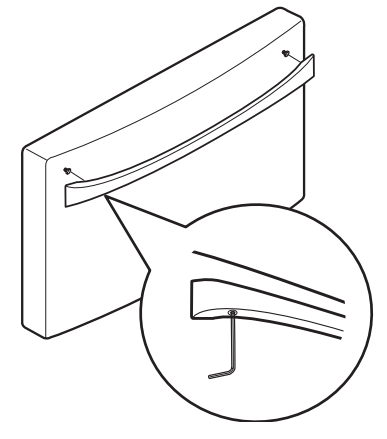
REMOVING AND REPLACING REFRIGERATOR DOORS
To remove the left refrigerator door:
1. Remove top hinge cover using a phillips type screwdriver by removing 5 screws
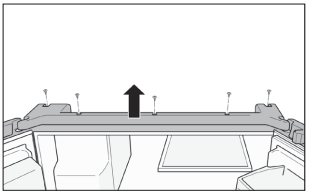
2. Remove the grounding wire screw and pull out the grounding wire (green with yellow stripe). Disconnect the main wire harness (blue and yellow wires).
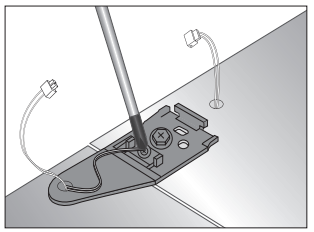
3. Using a large phillips screwdriver, turn top hinge fastener counterclockwise to remove the top hinge plate. CAUTION: After the hinge is removed, the door can fall down forward. Hold the door to prevent it from falling.
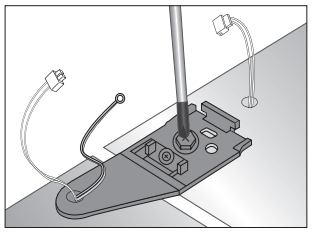
4. Lift the door from the middle hinge pin and remove the door. Place the door, inside facing up, on a nonscratch surface.

To remove the right refrigerator door:
1. Remove top hinge cover using a phillips type screwdriver by removing 5 screws.

2. Using a large phillips screwdriver, turn top hinge fastener counterclockwise to remove the top hinge/ plate.
CAUTION: After the hinge is removed, the door can fall down forward. Please secure door during this process.

3. Lift the door from the middle hinge pin and remove the door. Place the door, inside facing up, on a nonscratch surface.
Reinstalling the Left Refrigerator Door
1. Lower the door onto the middle hinge.
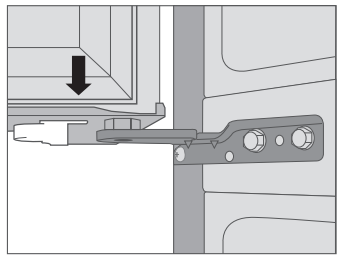
2. Fit the top hinge over the mounting holes and align to proper position before tightening. Turn top hinge screw clockwise to secure the hinge. Insert the ground wire screw and tighten the ground wire (green with yellow stripe) securely beneath it. Reconnect the main wire harness (blue and yellow wires).
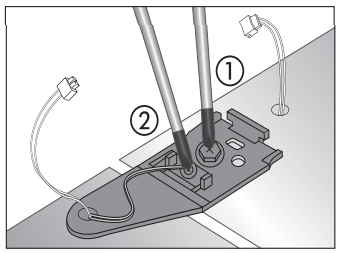
3. Screw top hinge cover into place with a screwdriver.
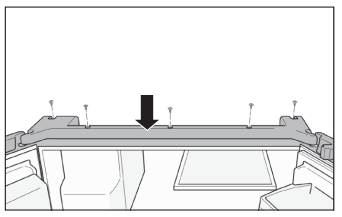
Reinstalling the Right Refrigerator Door
1. Lower the door onto the middle hinge.

2. Fit the top hinge over the mounting holes and align to proper position before tightening. Turn top hinge fastener clockwise to secure the hinge.
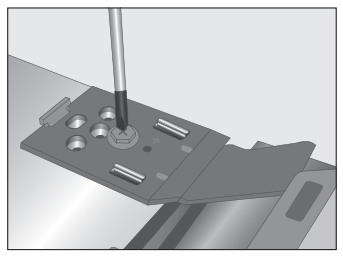
3. Screw top hinge cover into place with a screwdriver.

HOW TO REMOVE THE FREEZER DRAWER
WARNING: Use two or more people to remove and install the freezer drawer. Failure to do so can result in personal injury, product or property damage.
1. Take out the ice bin first, and then take out the upper freezer drawer by lifting it up.

2. Remove lower freezer basket by pulling up and tilting toward refrigerator until it can be removed from the freezer drawer/door assembly.
3. Push the rail support locking tabs to release the main freezer drawer rails from the cabinet while slightly pulling the exterior freezer drawer outwards, so that the locking tab does not return to the locked position. The locking tabs are located in the freezer compartment to the rear of the main rail assembly (which is attached to main exterior freezer drawer) as shown in the illustration below.

4. Pull exterior freezer drawer to fully disengage the rail assembly from the unit. Use 2 people for this task as the door is heavy and awkward to handle.
CAUTION: Do not hold the handle when removing or replacing the drawer. The handle may come off and it could cause personal injury.
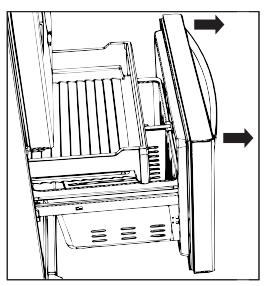
5. Place the door on a non-scratch surface.
HOW TO INSTALL THE FREEZER DRAWER
1. Using 2 people (recommended), align end of the exterior drawer rails to the lower rail guides located on the sidewalls of the freezer compartment. Make sure the gear teeth are engaged to the gear rail the same amount on both sides.
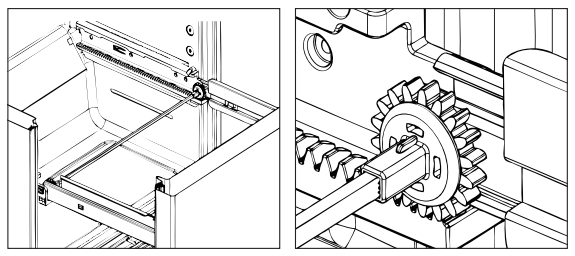
2. Fully push in and close freezer drawer to engage rails with rail support locking tab, applying a bit of pressure after the door is closed to seat the tabs to the rail.
CAUTION: Make sure the tabs are completely engaged to the rail or the refrigerator drawer could be pulled out of the refrigerator by the customer. Fully open the freezer door to check and see if the locking tabs are fully engaged. If they are not engaged, gently push each freezer rail with a flat head screwdriver towards the freezer compartment until the locking tabs snap to the locked position.

3. Replace the lower freezer drawer basket
4. Insert the upper freezer drawer above the lower basket, and replace ice bin.

5. Open and close the freezer drawer several times to make sure operation is smooth and seal is consistent all the way around the freezer compartment.
REFRIGERATOR LEVELING & DOOR ADJUSTMENT
The refrigerator must be level in order to maintain optimal performance and desirable front appearance. (If the floor beneath the refrigerator is uneven, the freezer and refrigerator doors look unbalanced.)
Leveling Refrigerator
- Fully open the freezer drawer and remove the freezer drawer basket to gain access to the lower toe guard fasteners.
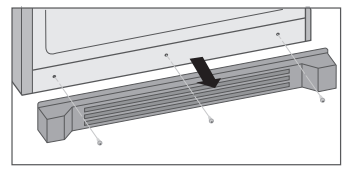
- Remove the lower toe guard using a phillips screwdriver.
- NOTE: Put screws in safe location so they are not lost.
- Using the wrench provided, turn the leveling leg clockwise to lower and counterclockwise to raise the front corners of the refrigerator.

- Install lower toe guard/grille using a phillips screwdriver.
- Install freezer drawer basket, then open and close the freezer drawer several times to make sure operation is smooth without hindrance.
Adjusting a refrigerator door
If the height of the refrigerator doors is uneven, turn the screw nut on the middle hinge to adjust the refrigerator door.
- To raise a refrigerator door turn the screw counterclockwise.

- To lower a refrigerator door turn the screw clockwise.

Adjusting the freezer drawer
(If the freezer drawer is higher on one side than the other (not even):
- Loosen the four side screws on the side where adjustment is needed.
- Move the Stopper from ‘left picture position’ to ‘right picture position’.
- Adjust the leveling by rotating the Position Knob. (Pull and rotate the Position Knob)
- After adjusting the leveling, tighten the four side screws.
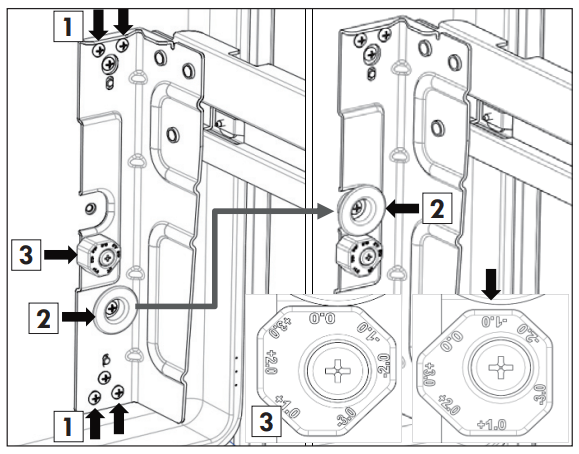
USING YOUR REFRIGERATOR
SETTING THE CONTROLS
Temperature Control
NOTE: When changing control settings, wait 24 hours before making additional adjustments. The controls are set correctly when milk or juice is as cold as you would like and when ice cream is firm. If the temperature in either compartment is too cold or too warm, change the setting one increment at a time. Wait 24 hours for the change to stabilize before adjusting again.
- The refrigerator temperature control is preset to 37 deg F (3 deg C) and the freezer control is preset to 0 deg F (-18 deg C). These are recommended temperature settings for normal use conditions.

Freezer Compartment
Push the Freezer button and the temperature setting changes in the sequence as shown below:

Accela Chill Freezer function:
To activate freezer Accela Chill, press and hold the Freezer button for 3 seconds. Accela Chill LED will turn on. Push the button again to cancel.
The Accela Chill function is useful to help quickly chill the freezer compartment when needed. For example: If a large quantity of warm food is placed inside the freezer, or if loading the freezer with new groceries which may not be as cold as normal freezer temperatures.
Accela Chill will automatically cancel (Accela Chill LED will turn off) after 50 hours.
Refrigerator Compartment
Push the Refrigerator button and the temperature setting changes in the sequence as shown below:

Accela Chill Refrigerator function:
To activate refrigerator Accela Chill, press and hold the Refrigerator button for 3 seconds. Accela Chill LED will turn on. Push the button again to cancel.
The Accela Chill function is useful to help quickly cool the refrigerator compartment when needed. For example: If a large quantity of warm food is placed inside the refrigerator, or if loading the refrigerator with new groceries which may not be as cold as normal refrigerator temperatures.
Accela Chill refrigerator function will automatically cancel (Accela Chill LED will turn off) after 6 hours
Demo Mode (For Store Use Only)
The Demo Mode disables all cooling in the refrigerator and freezer sections to conserve energy while on display in a retail store.
When Demo Mode is active, the display panel can be demonstrated without activating cooling operation.
To activate or deactivate:
Press Door Alarm button 5 times while pressing and holding Ice Maker and Freezer Temp buttons

Control Panel

1. Ice Maker button
Press to turn Ice Maker On or Off. If you do not intend to use any ice cubes for longer than one week (e.g. because you are going on holiday), shut down the ice maker. Initial status: Ice Maker On (LED off) Press Ice Maker button: Ice Maker OFF (LED on)
2. Freezer Temp button
Press to adjust freezer compartment temperature.
3. Refrigerator button
Press to adjust refrigerator compartment temperature.
4. Door Alarm
When either the refrigerator or the freezer door is left open for more than one minute, the Door Alarm button LED will illuminate and an audible alarm will sound to alert you that the door is open. To turn off the alarm, press the DOOR ALARM button.
5. ACCELA CHILL (ACCELA CHILL)
Illuminates when ACCELA CHILL function is ON.
6. Temperature Mode Switch Function ( °F ↔°C ) If you want to convert from °F to °C or vice versa: Press and hold the Freezer Temp and Refrigerator Temp for 5 seconds until the temperature mode changes.
ICEMAKER
In case the icemaker doesn’t work
If the ice maker doesn’t work, check the following:
- Has it been less than 12 hours since the water supply line installation?
- Is the water line connected and the shut-off valve opened?
- Did you manually stop the ice making function?
- Is the freezer temperature too warm? Try setting the freezer temperature lower.
In case of power failure
In the event of a lengthy power failure, remove ice cubes from the storage bin as the ice may melt.
Shutting down the ice maker
Important!
If you do not intend to use any ice cubes for longer than one week (e.g. because you are going on holiday), shut down the ice maker for that period in order to prevent ice cubes from freezing together.
- Press the On/Off button for 5 seconds to turn the ice maker off (LED on)
- Empty and clean the ice cube bin.
- Return the ice cube bin into position.

Reactivating the ice maker:
Press the button for 5 seconds to turn the ice maker on (LED off)
FOOD STORAGE GUIDE
- Wash food before storing
- Divide and separate food into smaller pieces.
- Place watery food or food with a lot of moisture in front shelves (close to door side). If they are placed close to the cold air vent, they can be frozen.
- Warm or hot food should be cooled down enough before storing to reduce power consumption and to enhance refrigeration performance.
- Be careful in storing tropical fruits such as bananas, pineapples and tomatoes, as they can easily deteriorate in lower temperatures.
- Keep enough space between the food items. If too tight or too close, cold air circulation is hindered, resulting in poor refrigeration.
- Never forget to cover or wrap food to prevent odors.
WHEN TO SET ICEMAKER TO OFF
- When the water supply will be shut off for several hours.
- When the ice bin is removed for more than one or two minutes.
- When the refrigerator will not be used for several days.
NOTE: The ice bin should be emptied when the icemaker ON/OFF button is turned to the OFF mode.
PREPARING FOR VACATION
Set the icemaker ON/OFF button to OFF and shut off the water supply to the refrigerator.
NOTE: The ice bin should be emptied any time the icemaker ON/OFF button is turned OFF.
If the ambient temperature will drop below freezing, have a qualified technician drain the water supply system to prevent serious property damage due to flooding caused by ruptured water lines or connections.
How to use the Automatic Icemaker
The ice maker will produce 7 cubes per cycle – approximately 50 to70 cubes in a 24-hour period – depending on freezer compartment temperature, room temperature, number of times freezer door is opened, and other use conditions.
Throw away the first few batches of ice to allow the water line to clear.
Be sure nothing interferes with the sweep of the ice maker feeler arm.
When the bin fills to the level of the feeler arm, the ice maker will stop producing ice.
After the ice maker has been turned on again, there will be a time delay before the ice maker resumes operation.
When ice dispenses, it is normal for several cubes to be joined together.
If ice is not dispensed on a regular basis, old ice cubes will discolor and shrink. If you won’t be using ice on a regular basis, turn the ice maker off.
STORING FROZEN FOOD
NOTE: Check a freezer guide or a reliable cookbook for further information about preparing food for freezing or food storage times.
Freezing
Your freezer will not quick-freeze a large quantity of food. Do not put more unfrozen food into the freezer than will freeze within 24 hours (no more than 2 to 3 lbs. of food per cubic foot of freezer space). Leave enough space in the freezer for air to circulate around packages. Be careful to leave enough room at the front so the door can close tightly.
Storage times will vary according to the quality and type of food, the type of packaging or wrap used (how airtight and moisture-proof) and the storage temperature. Ice crystals inside a sealed package are normal. This simply means that moisture in the food and air inside the package have condensed, creating ice crystals.
NOTE: Allow hot foods to cool at room temperature for 30 minutes, then package and freeze. Cooling hot foods before freezing saves energy.
Packaging
Successful freezing depends on correct packaging. When you close and seal the package, it must not allow air or moisture in or out. If it does, you could have food odor and taste transfer throughout the refrigerator and could also dry out frozen food.
Packaging recommendations:
- Rigid plastic containers with tight-fitting lids
- Straight-sided canning/freezing jars
- Heavy-duty aluminum foil
- Plastic-coated paper
- Non-permeable plastic wraps
- Specified freezer-grade self-sealing plastic bags
Follow package or container instructions for proper freezing methods.
Do not use
- Bread wrappers
- Non-polyethylene plastic containers
- Containers without tight lids
- Wax paper or wax-coated freezer wrap
- Thin, semi-permeable wrap
CAUTION: Do not keep beverage cans or plastic food containers in the freezer compartment. They may break or burst if they freeze.
REFRIGERATOR SECTION
Foldaway door bar (mullion bar)
- When closing the left refrigerator door, the mullion bar folds behind the right refrigerator door, forming a seal between the refrigerator doors.
- When opening the left refrigerator door, the mullion bar folds back to the left door automatically
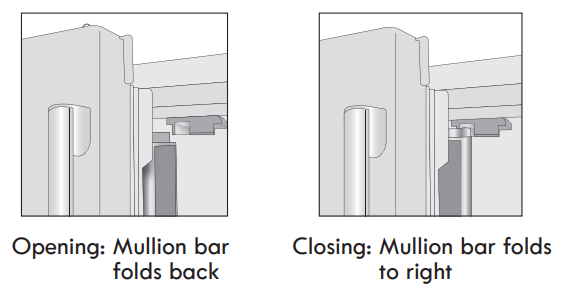
- The mullion bar may become damaged upon closing if it has been extended to the right while the door left door is open.
CAUTION: Before closing the left refrigerator door, make sure the mullion bar is folded back to the left door position or product damage may result.
REFRIGERATOR SHELVES
The shelves in your refrigerator are adjustable to meet your individual storage needs. Your model may have glass or wire shelves.
Adjusting the shelves to fit different heights of items will make finding the exact item you want easier. Doing so will also reduce the amount of time the refrigerator door is open which will save energy.
IMPORTANT: Do not clean glass shelves with warm water while they are cold. Shelves may break if exposed to sudden temperature changes or impact.
CAUTION: Glass shelves are heavy. Use special care when removing them.
Adjusting Shelves (Cantilever)
Remove shelves from the shipping position and replace shelves in the position you want.
- To remove a shelf: Lift up on front of shelf with one hand and with other hand push up on back of shelf to release attachment hooks from attachment slots. Pull the shelf out.

- To reinstall a shelf: With front of shelf angled slightly up, engage hooks on back of shelf into attachment slots, and then lower front of shelf into place.

CAUTION: Make sure that shelves are level from one side to the other. Failure to do so may result in the shelf falling or spilling food.
HUMIDITY CONTROLLED CRISPER
The crispers provide fresher tasting fruit and vegetables by letting you easily control humidity inside the drawer.
You can control the amount of humidity in the moisture sealed crispers crispers by adjusting the control to any setting between VEGETABLES and FRUIT.
- Slide the Humidity Control toward “hi” to keep moist air in crisper for best storage of fresh, leafy vegetables.
- Slide the Humidity Control toward “lo” to release moist air from crisper for best storage of fruit

REMOVING THE HUMIDITY CONTROLLED CRISPER
- To remove, pull the drawer out to full extension.
- Lift the front of the crisper up, then pull it straight out.
- To install, slightly tilt up the front, insert the drawer into the frame and push it back into place

DOOR BIN
The door bins are removable for easy cleaning and adjustment.
- To remove the bin, simply lift the bin up and pull straight out.
- To replace the bin, slide it in above the desired support and push down until it snaps into place.
NOTE: Some bins may vary in appearance and will only fit in one location.
CAUTION: Do not overfill or pack items too tightly into door bins. Doing so may cause damage to the bin or personal injury if items are removed with excessive force.
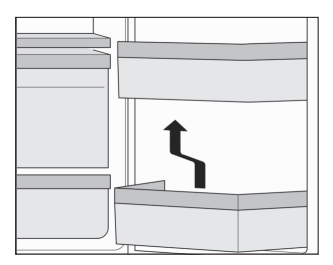
CONNECTING THE WATER LINE
BEFORE YOU BEGIN
This water line installation is not covered by the refrigerator warranty. Follow these instructions carefully to minimize the risk of expensive water damage.
Water hammer (water banging in the pipes) in house plumbing can cause damage to refrigerator parts and can lead to water leakage or flooding. Call a qualified plumber to correct water hamme
CAUTION: To prevent burns and product damage, only connect the refrigerator water line to a cold water supply.
If you use your refrigerator before connecting the water line, make sure the icemaker is turned OFF at the control panel.
CAUTION: Do not install the icemaker tubing in areas where temperatures fall below freezing.
WATER PRESSURE
The water pressure must be from 30 to 125 psi or 207-862 kPa or 2.1-8.8 kgf/cm2. If the refrigerator is installed in an area with low water pressure “below 30 psi”, you can install a booster pump to compensate for the low pressure.
WATER SUPPLY KIT
* Connecting the water line to the refrigerator

Parts that are not supplied are available from local service dealers.
- Connect water line to the compression fitting.
- If you are using copper tubing (not supplied), slip the compression nut (not supplied) and ferrule (not supplied) onto copper tubing.
- If you are using plastic tubing (not supplied), insert the molded ending of the plastic tubing into the compression fitting.
- Tighten the compression nut onto the compression fitting.
- Turn the water on and check for any leakage.
CARE AND CLEANING

* Features may vary according to model.
1. Ice Storage Bin
Cleaning: Empty the ice cube bin and clean with lukewarm water. Thoroughly dry the bin and screw conveyor to prevent new ice cubes from sticking together.
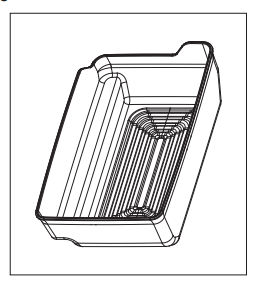
2. Freezer & Refrigerator Bins
Hold both ends and pull up.
3. Refrigerator Shelves
To remove a shelf: Lift up on front of shelf with one hand and with other hand push up on back of shelf to release attachment hooks from attachment slots. Pull the shelf out.

To reinstall a shelf: With front of shelf angled slightly up, engage hooks on back of shelf into attachment slots, and then lower front of shelf into place.

CAUTION: Make sure that shelves are level from one side to the other. Failure to do so may result in the shelf falling or spilling food.
LIGHT BULB REPLACEMENT
NOTE: The refrigerator and freezer compartment lights have LED interior lighting, and service should be performed by a qualified technician.
POWER INTERRUPTIONS
- If the power will be out for 24 hours or less, keep all refrigerator doors closed to help foods stay cold and frozen.
- If the power will be out for more than 24 hours, remove all frozen food and store it in a frozen food locker.
WHEN YOU GO ON VACATION
If you choose to leave the refrigerator on while you are away, follow these steps to prepare your refrigerator before you leave.
- Use up any perishables and freeze other items.
- Turn off the icemaker and empty the ice bin.
If you choose to turn the refrigerator off before you leave, follow these steps.
- Remove all food from the refrigerator.
- Clean the refrigerator, wipe it and dry well.
- Tape rubber or wood blocks to the tops of both doors to prop them open far enough for air to get in. This stops odor and mold from building up.
WHEN YOU MOVE
When you are moving your refrigerator to a new home, follow these steps to prepare it for the move.
- Remove all food from the refrigerator and pack all frozen food in dry ice.
- Unplug the refrigerator.
- Clean, wipe and dry thoroughly.
- Take out all removable parts, wrap them well and tape them together so they do not shift and rattle during the move. Refer to the Using your Refrigerator section for removing instructions.
- Tape the doors shut and tape the power cord to the refrigerator cabinet.
When you get to your new home, put everything back and refer to the Refrigerator Installation section for preparation instructions.
TROUBLESHOOTING GUIDE
COOLING
|
Problem |
Possible Causes |
Solutions |
|
Refrigerator and Freezer section are not cooling.
|
Refrigerator is set to demo mode. |
Demo Mode allows the lights and control display to work normally while disabling cooling to save energy while on the showroom floor. Refer to the Setting the Controls section for instructions on how to disable Demo Mode. |
|
Refrigerator is in the defrost cycle. |
During the defrost cycle, the temperature of each compartment may raise slightly. Wait 30 minutes and confirm the proper temperature has been restored once the defrost cycle has completed. |
|
|
Refrigerator was recently installed. |
It may take up to 24 hours for each compartment to reach the desired temperature. |
|
|
Refrigerator was recently relocated. |
If the refrigerator was stored for a long period of time or moved on its side, it is necessary for the refrigerator to stand upright for 24 hours before connecting it to power. |
|
|
Cooling System runs too much.
|
Refrigerator is replacing an older model. |
Modern refrigerators require more operating time but use less energy due to more efficient technology. |
|
Refrigerator was recently plugged in or power restored. |
The refrigerator will take up to 24 hours to cool completely. |
|
|
Door opened often or a large amount of food / hot food was added. |
Adding food and opening the door warms the refrigerator, requiring the compressor to run longer in order to cool the refrigerator back down. In order to conserve energy, try to get everything you need out of the refrigerator at once, keep food organized so it is easy to find, and close the door as soon as the food is removed. (Refer to the Food Storage Guide.) |
|
|
Doors are not closed completely. |
Firmly push the doors shut. If they will not shut all the way, see the Doors will not close completely or pop open section in Parts & Features Troubleshooting. |
|
|
Refrigerator is installed in a hot location. |
The compressor will run longer under warm conditions. At normal room temperatures (70°F) expect your compressor to run about 40% to 80% of the time. Under warmer conditions, expect it to run even more often. The refrigerator should not be operated above 110°F. |
|
|
Condenser / back cover is clogged. |
Use a vacuum cleaner with an attachment to clean the condenser cover and vents. Do not remove the panel covering the condenser coil area. |
|
Problem |
Possible Causes |
Solutions |
|
Refrigerator or Freezer section is too warm.
|
Refrigerator was recently installed. |
It may take up to 24 hours for each compartment to reach the desired temperature. |
|
Doors are opened often or for long periods of time. |
When the doors are opened often or for long periods of time, warm, humid air enters the compartment. This raises the temperature and moisture level within the compartment. To lessen the effect, reduce the frequency and duration of door openings. |
|
|
Unit is installed in a hot location. |
The refrigerator should not be operated in temperatures above 110F. |
|
|
A large amount of food or hot food was added to either compartment. |
Adding food warms the compartment requiring the cooling system to run. Allowing hot food to cool to room temperature before putting it in the refrigerator will reduce this effect. |
|
|
Doors not closed correctly. |
See the Doors will not close correctly or pop open section in Parts & Features Troubleshooting |
|
|
Temperature control is not set correctly. |
If the temperature is too warm, adjust the control one increment at a time and wait for the temperature to stabilize. Refer to the Setting the Controls section for more information. |
|
|
Defrost cycle has recently completed. |
During the defrost cycle, the temperature of each compartment may raise slightly and condensation may form on the back wall. Wait 30 minutes and confirm the proper temperature has been restored once the defrost cycle has completed. |
|
|
Interior moisture buildup.
|
Doors are opened often or for long periods of time. |
When the doors are opened often or for long periods of time, warm, humid air enters the compartment. This raises the temperature and moisture level within the compartment. To lessen the effect, reduce the frequency and duration of door openings. |
|
Doors not closed correctly. |
See the Doors will not close correctly section in the Troubleshooting section. |
|
|
Weather is humid. |
Humid weather allows additional moisture to enter the compartments when the doors are opened leading to condensation or frost. Maintaining a reasonable level of humidity in the home will help to control the amount of moisture that can enter the compartments. |
|
|
Defrost cycle recently completed. |
During the defrost cycle, the temperature of each compartment may raise slightly and condensation may form on the back wall. Wait 30 minutes and confirm that the proper temperature has been restored once the defrost cycle has completed. |
|
|
Food is not packaged correctly. |
Food stored uncovered or unwrapped, and damp containers can lead to moisture accumulation within each compartment. Wipe all containers dry and store food in sealed packaging to prevent condensation and frost. |
COOLING/ICE & WATER
|
Problem |
Possible Causes |
Solutions |
|
Food is freezing in the refrigerator compartment. |
Food with high water content was placed near an air vent. |
Rearrange items with high water content away from air vents. |
|
Refrigerator temperature control is set incorrectly. |
If the temperature is too cold, adjust the control one increment at a time and wait for the temperature to stabilize. Refer to the Setting the Controls section for more information. |
|
|
Refrigerator is installed in a cold location. |
When the refrigerator is operated in temperature below 41°F (5°C), food can freeze in the refrigerator compartment. The refrigerator should not be operated in temperature below 55°F (13°C). |
|
|
Frost or ice crystals form on frozen food (outside of package). |
Door is opened frequently or for long periods of time. |
When the doors are opened often or for long periods of time, warm, humid air enters the compartment. This raises the temperature and moisture level within the compartment. Increased moisture will lead to frost and condensation. To lessen the effect, reduce the frequency and duration of door openings. |
|
Door is not closing properly. |
Refer to the Doors will not close correctly or pop open section in the Troubleshooting section. |
|
|
Refrigerator or Freezer section is too cold. |
Incorrect temperature control settings. |
If the temperature is too cold, adjust the control one increment at a time and wait for the temperature to stabilize. Refer to the Setting the Controls section for more information. |
|
Frost or ice crystals on frozen food (inside of sealed package). |
Condensation from food with a high water content has frozen inside of the food package. |
This is normal for food items with a high water content. |
|
Food has been left in the freezer for a long period of time. |
Do not store food items with high water content in the freezer for a long period of time. |
|
|
Icemaker is not making enough ice. |
Demand exceeds ice storage capacity. |
The ice maker will product approximately 50 to 70 cubes in a 24 hour period. |
|
House water supply is not connected, valve is not turned on fully, or valve is clogged. |
Connect the refrigerator to a cold water supply with adequate pressure and turn the water shutoff valve fully open. If the problem persists, it may be necessary to contact a plumber. |
|
|
Low house water supply pressure. |
NOTE: The water pressure must be from 30 to 125 psi or 207-862 kPa or 2.1-8.8 kgf/cm2. If the refrigerator is installed in an area with low water pressure below 30 psi, you can install a booster pump to compensate for the low pressure. If the problem persists, it may be necessary to contact a plumber or install a booster pump to compensate for the low pressure. |
|
|
Reverse Osmosis filtration system is used. |
Reverse osmosis filtration systems can reduce the water pressure below the minimum amount and result in icemaker issues. (Refer to Water Pressure section.) |
|
|
Tubing connecting refrigerator to house supply valve is kinked. |
The tubing can kink when the refrigerator is moved during installation or cleaning resulting in reduced water flow. Straighten or repair the water supply line and arrange it to prevent future kinks. |
ICE & WATER
|
Problem |
Possible Causes |
Solutions |
|
Icemaker is not making ice.
|
Refrigerator was recently installed or icemaker recently connected. |
It may take up to 24 hours for each compartment to reach the desired temperature and for the icemaker to begin making ice. |
|
Icemaker not turned on. |
Locate the icemaker on/of button and confirm that it is turned ON. |
|
|
The refrigerator is not connected to a water supply or the supply shutoff valve is not turned on. |
Connect refrigerator to the water supply and turn the water shutoff valve fully open. |
|
|
Icemaker shutoff (feeler arm) obstructed. |
If your icemaker is equipped with an ice shutoff arm, make sure that the arm moves freely. |
|
|
Ice has bad taste or odor.
|
Water supply contains minerals such as sulfur. |
A water filter may need to be installed to eliminate taste and odor problems. NOTE: In some cases, a filter may not help. It may not be possible to remove all minerals / odor / taste in all water supplies. |
|
Icemaker was recently installed. |
Discard the first few batches of ice to avoid discolored or bad tasting ice. |
|
|
Ice has been stored for too long. |
Ice that has been stored for too long will shrink, become cloudy, and may develop a stale taste. Throw away old ice and make a new supply. |
|
|
The food has not been stored properly in either compartment. |
Rewrap the food. Odors may migrate to the ice if food is not wrapped properly. |
|
|
The interior of the refrigerator needs to be cleaned. |
See the Care and Cleaning section for more information. |
|
|
The ice storage bin needs to be cleaned. |
Empty and wash the bin (discard old cubes). Make sure that the bin is completely dry before reinstalling it. |
|
|
Icemaker is making too much ice. |
Icemaker shutoff (feeler arm) is obstructed. |
Empty the ice bin. If your icemaker is equipped with an ice shutoff arm, make sure that the arm moves freely. Reinstall the ice bin and wait 24 hours to confirm proper operation. |
NOISE
|
Problem |
Possible Causes |
Solutions |
|
Clicking |
The defrost control will click when the automatic defrost cycle begins and ends. The thermostat control (or refrigerator control on some models) will also click when cycling on and off. |
Normal Operation |
|
Rattling |
Rattling noises may come from the flow of refrigerant, the water line on the back of the unit, or items stored on top of or around the refrigerator. |
Normal Operation |
|
Refrigerator is not resting solidly on the floor. |
Floor is weak or uneven or leveling legs need to be adjusted. See the Door Alignment section. |
|
|
Refrigerator with linear compressor was jarred while running. |
Normal Operation |
|
|
Whooshing |
Evaporator fan motor is circulating air through the refrigerator and freezer compartments. |
Normal Operation |
|
Air is being forced over the condenser by the condenser fan. |
Normal Operation |
|
|
Gurgling |
Refrigerant flowing through the cooling system. |
Normal Operation |
|
Popping |
Contraction and expansion of the inside walls due to changes in temperature. |
Normal Operation |
|
Sizzling |
Water dripping on the defrost heater during a defrost cycle. |
Normal Operation |
|
Vibrating |
If the side or back of the refrigerator is touching a cabinet or wall, some of the normal vibrations may make an audible sound. |
To eliminate the noise, make sure that the sides and back cannot vibrate against any wall or cabinet. |
|
Dripping |
Water running into the drain pan during the defrost cycle. |
Normal Operation |
|
Pulsating or High-Pitched Sound |
Your refrigerator is designed to run more efficiently to keep your food items at the desired temperature. The high efficiency compressor may cause your new refrigerator to run longer than your old one, but it is still more energy efficient than previous models. While the refrigerator is running, it is normal to hear a pulsating or highpitched sound. |
Normal Operation |
PARTS & FEATURES
|
Problem |
Possible Causes |
Solutions |
|
Doors will not close correctly or pop open. |
Food packages are blocking the door open. |
Rearrange food containers to clear the door and door shelves. |
|
Ice bin, crisper cover, pans, shelves, door bins, or baskets are out of position. |
Push bins all the way in and put crisper cover, pans, shelves and baskets into their correct positions. See the Using Your Refrigerator section for more information. |
|
|
The doors were removed during product installation and not properly replaced. |
Remove and replace the doors according to the Removing and Replacing Refrigerator Handles and Doors section. |
|
|
Refrigerator is not leveled properly. |
See Door Alignment in the Refrigeration Installation section to level refrigerator. |
|
|
Doors are difficult to open. |
The gaskets are dirty or sticky. |
Clean the gaskets and the surfaces that they touch. Rub a thin coat of appliance polish or kitchen wax on the gaskets after cleaning. |
|
Door was recently closed. |
When you open the door, warmer air enters the refrigerator. As the warm air cools, it can create a vacuum. If the door is hard to open, wait one minute to allow the air pressure to equalize, then see if it opens more easily. |
|
|
Refrigerator wobbles or seems unstable. |
Leveling legs are not adjusted properly. |
Refer to the Leveling and Door Alignment section. |
|
Floor is not level. |
It may be necessary to add shims under the leveling legs or rollers to complete installation. |
|
|
Lights do not work. |
LED interior lighting failure. |
The refrigerator compartment lamp is LED interior lighting, and service should be performed by a qualified technician. Refer to the Light Bulb Replacement section. |
|
The interior of the refrigerator is covered with dust or soot. |
The refrigerator is located near a fire source, such as a fireplace, chimney or candle. |
Make sure that the refrigerator is not located near a fire source, such as a fireplace, chimney or candle. |
